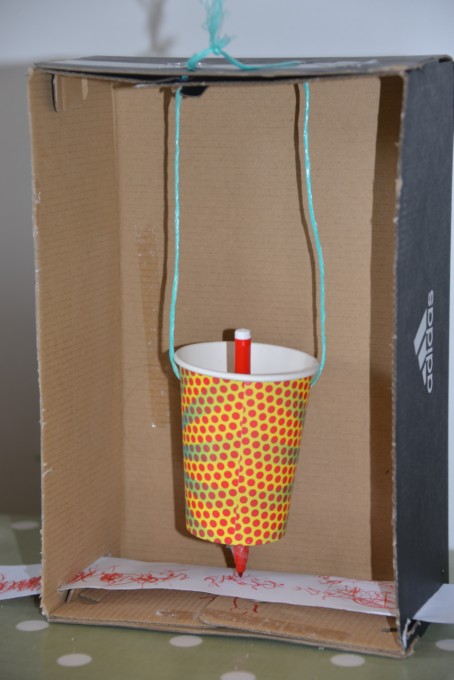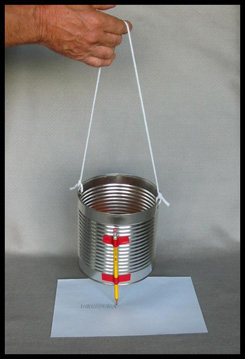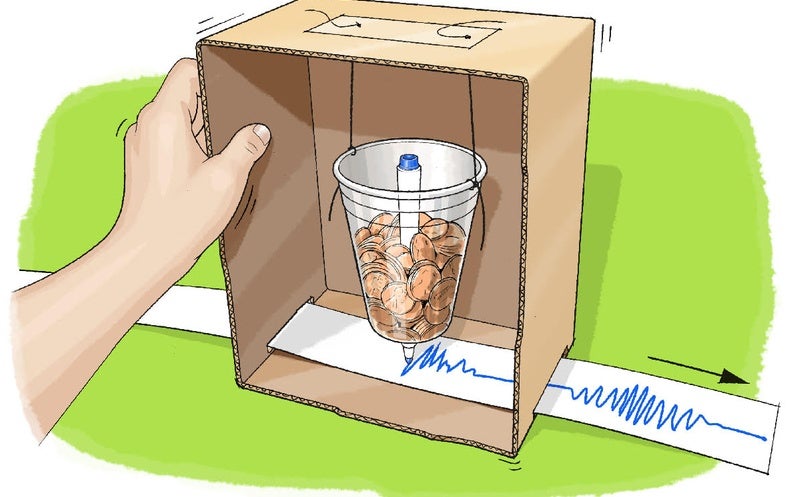How to make a seismograph model for kids
How To Make A Seismograph Model For Kids. In this activity students learn how a seismograph measures the shaking of the earth during an earthquake. You can find written directio. Poke two holes in the top of the box making sure they are the same distance apart as the holes in the cup. Tie a piece of string slightly longer than the length of the box to each hole.
 Build Your Own Seismograph With A Cardboard Box And A Plastic Cup Or Bottle For Earthquake Sc Earth Science Projects Science For Kids Cool Science Experiments From pinterest.com
Build Your Own Seismograph With A Cardboard Box And A Plastic Cup Or Bottle For Earthquake Sc Earth Science Projects Science For Kids Cool Science Experiments From pinterest.com
Seismometer instructions carefully make two holes in the top of the box ask a grown up to help with this part. Scientists use special machines called seismographs to record the seismic waves or movements in the earth s crust. This video will show you how to make your own seismograph a scientific instrument used to measure the strength of earthquakes. In this activity students learn how a seismograph measures the shaking of the earth during an earthquake. Poke two holes in the top of the box making sure they are the same distance apart as the holes in the cup. Push the two pieces of string through the holes and tie them together on the top of the box so the cup hangs down inside the box.
This video will show you how to make your own seismograph a scientific instrument used to measure the strength of earthquakes.
A typical seismograph has a pen attached to a heavy weight. Scientists use special machines called seismographs to record the seismic waves or movements in the earth s crust. In this activity students learn how a seismograph measures the shaking of the earth during an earthquake. This video will show you how to make your own seismograph a scientific instrument used to measure the strength of earthquakes. Poke two holes in the top of the box making sure they are the same distance apart as the holes in the cup. Tie a piece of string slightly longer than the length of the box to each hole.
 Source: sciencewithapop.weebly.com
Source: sciencewithapop.weebly.com
Scientists use special machines called seismographs to record the seismic waves or movements in the earth s crust. In this activity students learn how a seismograph measures the shaking of the earth during an earthquake. The pen touches a rotating cylinder of paper so that the pen draws a line as the cylinder rotates. A typical seismograph has a pen attached to a heavy weight. Poke two holes in the top of the box making sure they are the same distance apart as the holes in the cup.
 Source: m.youtube.com
Source: m.youtube.com
Next make another hole in the centre of the bottom of the plastic or paper cup and two holes on either side of the top of the cup. Push your pen or pencil through the bottom hole and make sure it s secure. You can make a simple seismograph in the following science experiment. Next make another hole in the centre of the bottom of the plastic or paper cup and two holes on either side of the top of the cup. Seismometer instructions carefully make two holes in the top of the box ask a grown up to help with this part.
 Source: pinterest.com
Source: pinterest.com
Push your pen or pencil through the bottom hole and make sure it s secure. You can find written directio. The pen touches a rotating cylinder of paper so that the pen draws a line as the cylinder rotates. Seismometer instructions carefully make two holes in the top of the box ask a grown up to help with this part. The weight is free to swing back and forth or to bounce up and down on a spring.
 Source: pinterest.com
Source: pinterest.com
You can make a simple seismograph in the following science experiment. Next make another hole in the centre of the bottom of the plastic or paper cup and two holes on either side of the top of the cup. You can find written directio. This video will show you how to make your own seismograph a scientific instrument used to measure the strength of earthquakes. Push your pen or pencil through the bottom hole and make sure it s secure.
 Source: pinterest.com
Source: pinterest.com
Tie a piece of string slightly longer than the length of the box to each hole. Next make another hole in the centre of the bottom of the plastic or paper cup and two holes on either side of the top of the cup. Each magnitude number on the richter scale represents the maximum amplitude of a seismic wave at a distance of about 160 kilometres. The weight is free to swing back and forth or to bounce up and down on a spring. In this activity students learn how a seismograph measures the shaking of the earth during an earthquake.
 Source: youtube.com
Source: youtube.com
The weight is free to swing back and forth or to bounce up and down on a spring. You can make a simple seismograph in the following science experiment. This video will show you how to make your own seismograph a scientific instrument used to measure the strength of earthquakes. The pen touches a rotating cylinder of paper so that the pen draws a line as the cylinder rotates. Each magnitude number on the richter scale represents the maximum amplitude of a seismic wave at a distance of about 160 kilometres.
 Source: m.youtube.com
Source: m.youtube.com
Poke two holes in the top of the box making sure they are the same distance apart as the holes in the cup. Push your pen or pencil through the bottom hole and make sure it s secure. Tie a piece of string slightly longer than the length of the box to each hole. Seismometer instructions carefully make two holes in the top of the box ask a grown up to help with this part. You can make a simple seismograph in the following science experiment.
 Source: amazon.in
Source: amazon.in
The weight is free to swing back and forth or to bounce up and down on a spring. Poke two holes in the top of the box making sure they are the same distance apart as the holes in the cup. A typical seismograph has a pen attached to a heavy weight. This video will show you how to make your own seismograph a scientific instrument used to measure the strength of earthquakes. Tie a piece of string slightly longer than the length of the box to each hole.
 Source: science-sparks.com
Source: science-sparks.com
Seismometer instructions carefully make two holes in the top of the box ask a grown up to help with this part. Tie a piece of string slightly longer than the length of the box to each hole. Push the two pieces of string through the holes and tie them together on the top of the box so the cup hangs down inside the box. Next make another hole in the centre of the bottom of the plastic or paper cup and two holes on either side of the top of the cup. You can make a simple seismograph in the following science experiment.
 Source: kids-earth-science.com
Source: kids-earth-science.com
Push your pen or pencil through the bottom hole and make sure it s secure. Seismometer instructions carefully make two holes in the top of the box ask a grown up to help with this part. Push your pen or pencil through the bottom hole and make sure it s secure. This video will show you how to make your own seismograph a scientific instrument used to measure the strength of earthquakes. Next make another hole in the centre of the bottom of the plastic or paper cup and two holes on either side of the top of the cup.
 Source: sciencebuddies.org
Source: sciencebuddies.org
A typical seismograph has a pen attached to a heavy weight. The pen touches a rotating cylinder of paper so that the pen draws a line as the cylinder rotates. This video will show you how to make your own seismograph a scientific instrument used to measure the strength of earthquakes. Push the two pieces of string through the holes and tie them together on the top of the box so the cup hangs down inside the box. Next make another hole in the centre of the bottom of the plastic or paper cup and two holes on either side of the top of the cup.
 Source: pinterest.com
Source: pinterest.com
Next make another hole in the centre of the bottom of the plastic or paper cup and two holes on either side of the top of the cup. This video will show you how to make your own seismograph a scientific instrument used to measure the strength of earthquakes. Tie a piece of string slightly longer than the length of the box to each hole. Next make another hole in the centre of the bottom of the plastic or paper cup and two holes on either side of the top of the cup. You can make a simple seismograph in the following science experiment.
 Source: scientificamerican.com
Source: scientificamerican.com
Each magnitude number on the richter scale represents the maximum amplitude of a seismic wave at a distance of about 160 kilometres. You can make a simple seismograph in the following science experiment. The pen touches a rotating cylinder of paper so that the pen draws a line as the cylinder rotates. In this activity students learn how a seismograph measures the shaking of the earth during an earthquake. The weight is free to swing back and forth or to bounce up and down on a spring.
 Source: kfvs12.com
Source: kfvs12.com
Each magnitude number on the richter scale represents the maximum amplitude of a seismic wave at a distance of about 160 kilometres. Next make another hole in the centre of the bottom of the plastic or paper cup and two holes on either side of the top of the cup. Seismometer instructions carefully make two holes in the top of the box ask a grown up to help with this part. Push the two pieces of string through the holes and tie them together on the top of the box so the cup hangs down inside the box. Scientists use special machines called seismographs to record the seismic waves or movements in the earth s crust.
 Source: youtube.com
Source: youtube.com
In this activity students learn how a seismograph measures the shaking of the earth during an earthquake. You can make a simple seismograph in the following science experiment. Push the two pieces of string through the holes and tie them together on the top of the box so the cup hangs down inside the box. Tie a piece of string slightly longer than the length of the box to each hole. In this activity students learn how a seismograph measures the shaking of the earth during an earthquake.
If you find this site beneficial, please support us by sharing this posts to your own social media accounts like Facebook, Instagram and so on or you can also bookmark this blog page with the title how to make a seismograph model for kids by using Ctrl + D for devices a laptop with a Windows operating system or Command + D for laptops with an Apple operating system. If you use a smartphone, you can also use the drawer menu of the browser you are using. Whether it’s a Windows, Mac, iOS or Android operating system, you will still be able to bookmark this website.






